In an era where smartphone cameras are increasingly sophisticated and mirrorless cameras are rising in popularity, one may question the relevance of the classic DSLR camera.
With its bulkier frame and often complex operational design, does the DSLR still hold its ground in the face of more compact, user-friendly options? Or are DSLR cameras obsolete?
Before jumping to conclusions, let’s delve into the intricacies of DSLR cameras, their unique strengths, and why they might still be a preferred choice for many photography enthusiasts.
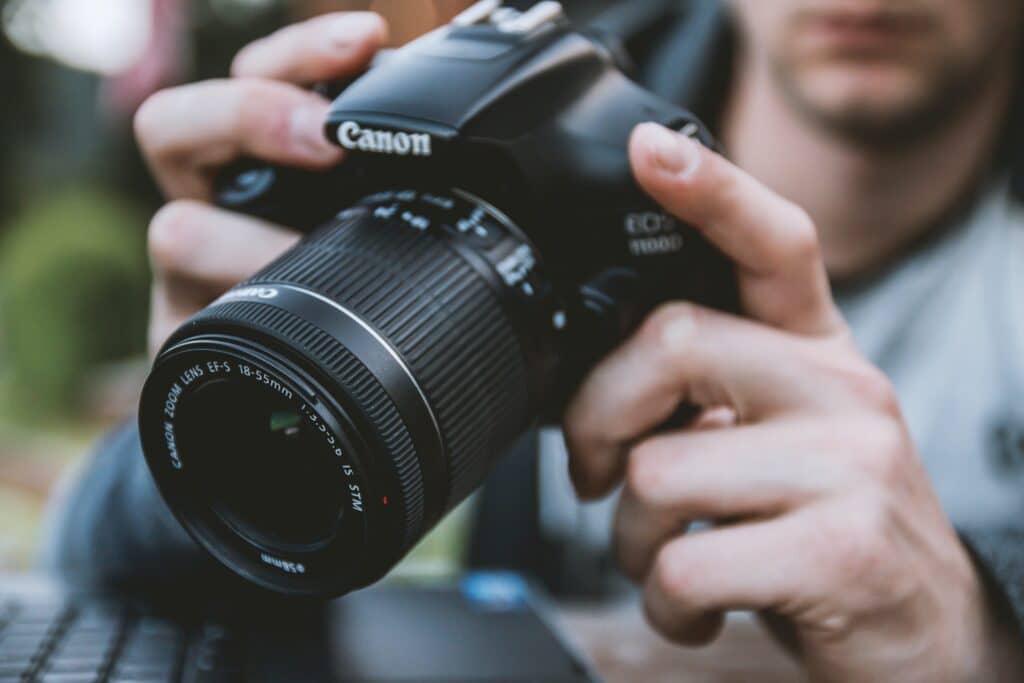
Related: iPhone 14 vs DSLR
Are DSLR Cameras Obsolete?
As technology evolves, so does the DSLR camera. Over time, these cameras have become more advanced, offering superior features that can be invaluable to professional photographers and hobbyists alike.
Advantages of DSLRs
1. Image Quality
DSLR cameras typically have larger sensors, which allow for greater pixel size. This results in superior image quality, especially in low light conditions. Their dynamic range is also impressive, capturing detailed images in both high-contrast and low-light scenarios.
2. Versatility
The versatility of DSLRs is another significant advantage. With their wide range of settings and customizable options, a DSLR camera can adapt to various shooting conditions, be it wildlife, portraits, or landscapes.
3. Lens Compatibility
DSLRs are compatible with a vast array of lenses. This compatibility opens the door to diverse photographic possibilities, whether you’re aiming for the close-up detail of a macro lens or the wide angle of a landscape lens.
Limitations of DSLRs
Despite the advantages, DSLRs are not without their limitations.
1. Size and Weight
DSLRs are bulkier and heavier than most of their counterparts. Their size can make them inconvenient to carry around, especially for travel or street photography.
2. Slow Autofocus in Live View
While DSLRs boast excellent autofocus through the viewfinder, they tend to lag in live view mode. This sluggishness can be a setback in scenarios that require quick focusing.
3. Limited Video Capabilities
The video capabilities of DSLRs are typically limited compared to mirrorless cameras. While some DSLRs do offer high-definition video, they usually lack the advanced video features found in mirrorless models, such as 4K resolution and high frame rates.
The Rise of Mirrorless Cameras
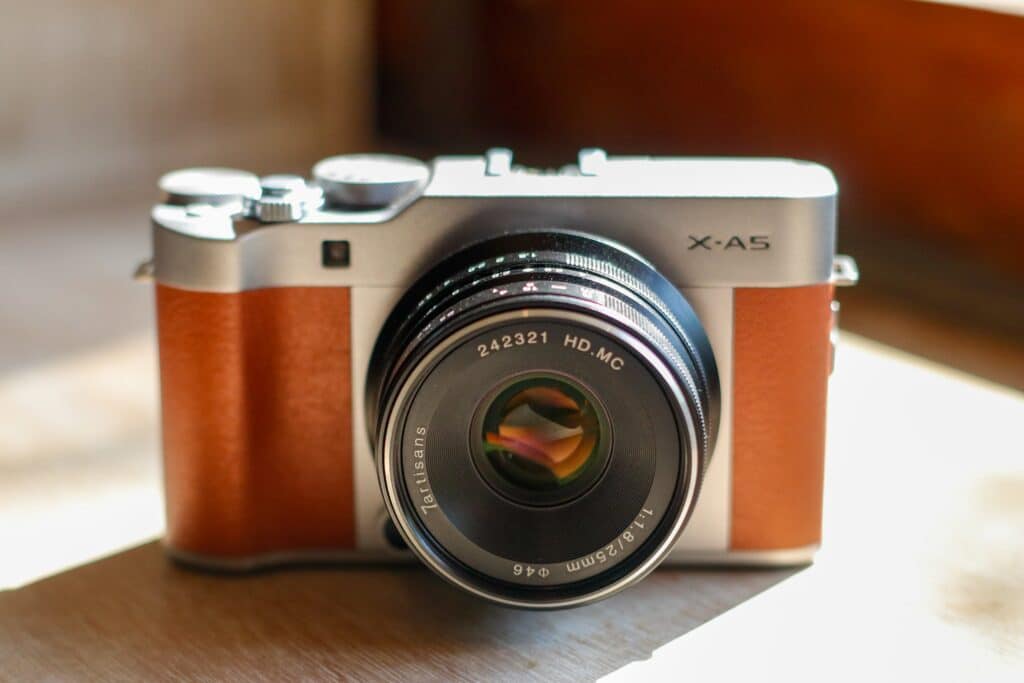
As DSLR cameras grapple with their limitations, a new breed of cameras is taking center stage – the mirrorless cameras.
Introduction to Mirrorless Technology
Unlike DSLRs that use a mirror mechanism to direct light from the lens to the optical viewfinder, mirrorless cameras eliminate this mirror system.
This leads to a smaller, lighter design with simplified mechanics. Light passes directly from the lens onto the image sensor, which transmits the digital image to the camera’s electronic viewfinder or rear screen.
Advantages of Mirrorless Cameras
1. Size and Portability
One of the defining features of mirrorless cameras is their compact size and lighter weight. This makes them ideal for photographers on the go, traveling light without compromising image quality.
2. Electronic Viewfinders (EVFs)
Mirrorless cameras feature Electronic Viewfinders (EVFs), which digitally preview what the camera sensor sees.
This lets the photographer see real-time exposure, white balance, and other image adjustments in the viewfinder.
3. Continuous Autofocus in Video
Mirrorless cameras excel in video autofocus. They offer continuous autofocus during video recording, allowing for smooth, crisp, and professional-looking video footage.
Mirrorless Camera Limitations
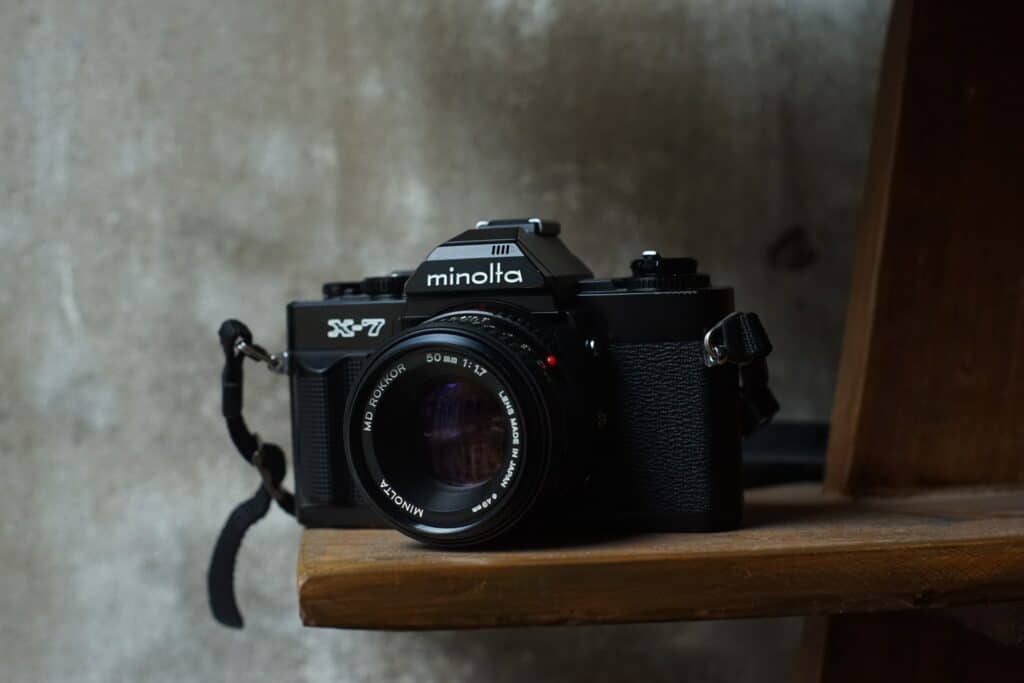
Despite their appealing advantages, mirrorless cameras are not without their shortcomings.
Battery Life
Mirrorless cameras often fall short in terms of battery life. Their smaller bodies leave less room for larger batteries, and the constant use of electronic viewfinders and screens tends to drain power quickly.
Lens Selection
As newer technology, mirrorless cameras don’t yet have the vast lens ecosystem that DSLRs do. Although the selection is continuously growing, it may not satisfy all photographers’ needs as of the current date.
A Detailed Comparison: DSLRs vs. Mirrorless Cameras
Image Quality and Sensor Size
In terms of image quality and sensor size, DSLRs often have the edge. Their larger sensors are capable of capturing more light, resulting in superior image quality, particularly in low-light conditions.
However, some mirrorless cameras now feature full-frame sensors, narrowing the gap in image quality between the two types.
Autofocus and Speed
When it comes to autofocus and speed, the two types of cameras excel in different areas. DSLRs offer impressive autofocus through the viewfinder, but they lag in live view.
In contrast, mirrorless cameras provide swift and accurate autofocus in both viewfinder and live view modes, making them a preferred choice for video recording or rapid shooting.
Size and Portability
Mirrorless cameras undeniably win in the size and portability category. Their compact size and lighter weight make them a convenient option for travel and street photography.
On the other hand, the larger size of DSLRs can be a deterrent to some photographers, especially those constantly on the move.
Battery Life and Performance
In terms of battery life and performance, DSLRs tend to outperform mirrorless cameras.
The smaller bodies of mirrorless cameras do not accommodate larger batteries, and the constant use of electronic viewfinders and screens drains their battery quickly. In contrast, DSLRs have a more extended battery life, allowing for longer shooting sessions.
Lens Compatibility and Selection
DSLRs boast a vast selection of compatible lenses, giving photographers a wide range of creative possibilities.
While the lens selection for mirrorless cameras is expanding, it’s still limited compared to that of DSLRs, which can be a significant factor for some photographers.
Video Capabilities
Mirrorless cameras are more advanced in terms of video capabilities. They offer features such as 4K resolution, high frame rates, and continuous autofocus during video recording.
While DSLRs can also offer high-definition video, they usually lack the depth and variety of video features that mirrorless cameras provide.
A Detailed Comparison: DSLRs vs. iPhone 14 Pro Max
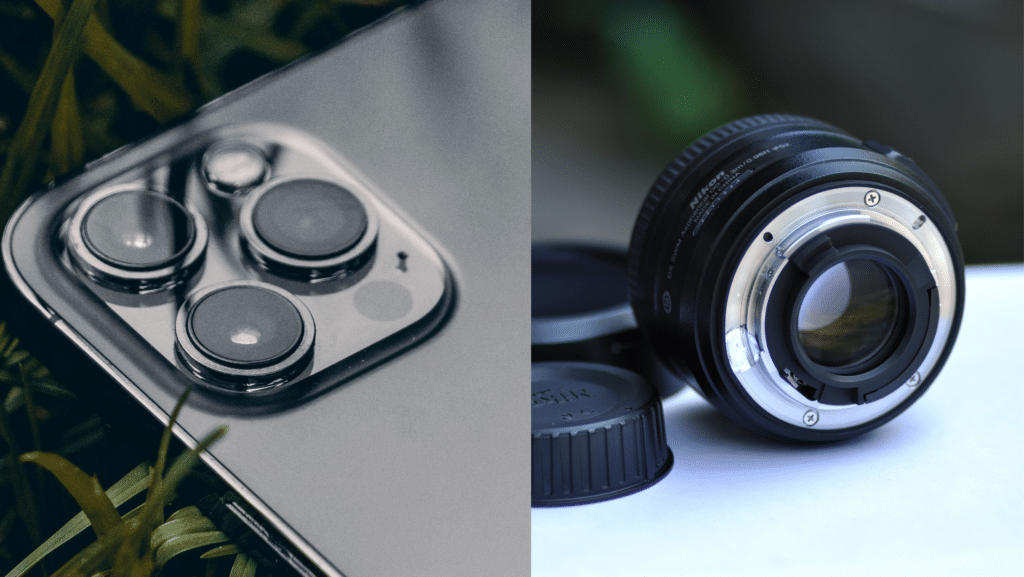
Image Quality and Sensor Size
DSLRs, with their larger sensors, are often touted for superior image quality, particularly in low-light conditions. However, the iPhone 14 Pro Max has made significant strides in its camera technology.
With its Pro Camera system that includes a 12 MP primary, 12 MP ultrawide, 12 MP telephoto lenses, and sensor-shift optical image stabilization, the iPhone 14 Pro Max delivers high-resolution photos that compete closely with those from DSLRs.
Autofocus and Speed
DSLRs are renowned for their impressive autofocus speed, especially when using the viewfinder. However, the iPhone 14 Pro Max also boasts excellent autofocus capabilities, enabled by advanced AI and machine learning algorithms.
With the addition of Photographic Styles and Smart HDR 4, your photos are intelligently adjusted for optimum results.
Size and Portability
Regarding size and portability, the iPhone 14 Pro Max is the clear winner. It fits comfortably into your pocket, making it the perfect companion for candid shots and on-the-go photography.
Despite the superior features of DSLRs, their bulky size can be a significant deterrent for users who prioritize portability.
Battery Life and Performance
DSLRs generally have an upper hand in battery life, particularly for extensive shooting sessions. However, the iPhone 14 Pro Max boasts a robust battery life lasting up to 75 hours on continuous audio playback.
While it may not match a DSLR for an all-day shoot, it provides sufficient power for general daily use and casual photography.
Lens Compatibility and Selection
In terms of lens compatibility and selection, the DSLR comes out ahead, offering a vast array of lenses for various photography needs.
However, the iPhone 14 Pro Max offers three distinct lenses – wide, ultra-wide, and telephoto – that cater to most casual photography situations.
Video Capabilities
The iPhone 14 Pro Max is a powerhouse in video capabilities. It supports 4K Dolby Vision HDR recording and ProRes, bringing professional video techniques to the iPhone.
While DSLRs offer high-definition video, they often lack advanced features like those found in the latest iPhones.
Industry Trends and Market Statistics

DSLR Sales Decline
The digital camera market has undergone significant changes recently, with DSLR sales witnessing a steady decline.
According to Camera & Imaging Products Association (CIPA) data, global DSLR shipments have plummeted from 12 million units in 2012 to about 2.4 million in 2020.
This downward trend indicates a shift in consumer preferences towards newer and more compact camera technology.
Mirrorless Camera Market Growth
Conversely, mirrorless cameras have been experiencing a surge in popularity.
CIPA data reveals that annual mirrorless camera shipments increased from approximately 1.5 million units in 2012 to around 4.5 million units in 2020.
The growth in this sector can be attributed to rapid technological advancements, superior video capabilities, and an expanding range of lenses.
Impact of Smartphones on the Market
The dominance of smartphones cannot be understated when discussing changing trends in the photography industry.
With significant tech giants continually enhancing their built-in camera systems, the line between professional and amateur photography is becoming increasingly blurred.
In 2019, a staggering 1.52 billion smartphones were sold globally, according to Statista, demonstrating the significant impact of this technology on the digital camera market.
Key Players in the Camera Industry
Several key players currently dominate the camera industry. Canon, Nikon, and Sony have long been the leading manufacturers of DSLR and mirrorless cameras, offering a wide range of models for all levels of photography.
On the other hand, in the smartphone sector, Apple and Samsung lead the pack, consistently innovating and improving their camera technology to compete with traditional digital cameras.
Future Prospects for DSLR Cameras
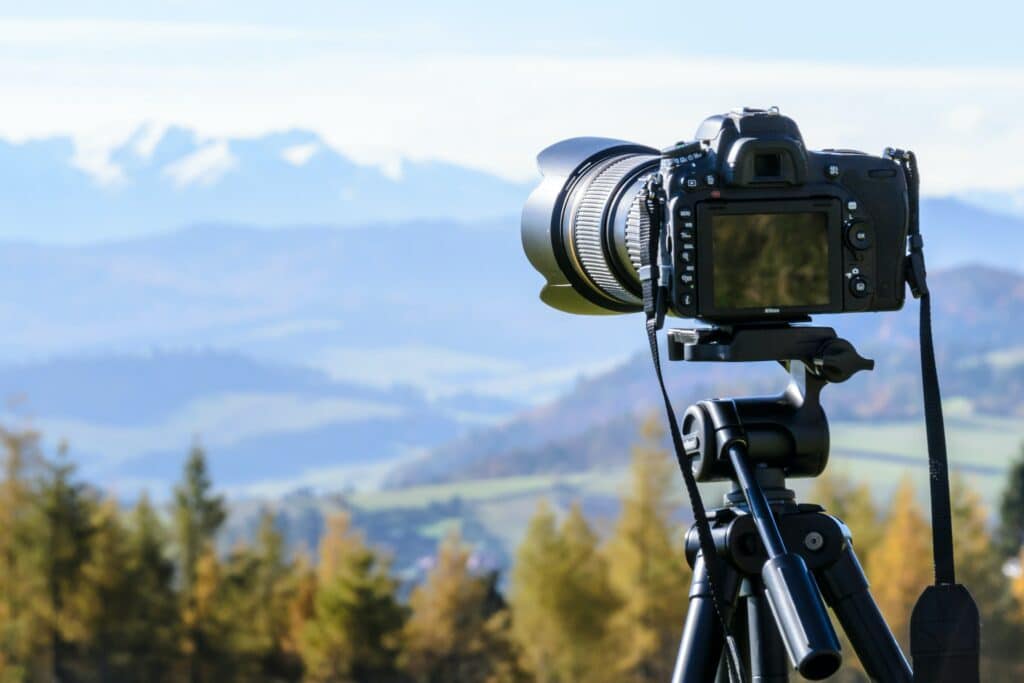
DSLR Niche Markets
Despite the shift in consumer preferences towards mirrorless cameras and enhanced smartphone photography, DSLR cameras remain strong in niche markets.
Professional photographers, particularly those specializing in wildlife, sports, and events photography, tend to favor the impeccable image quality, dynamic range, superior autofocus, and lens versatility that DSLRs offer.
Additionally, photography hobbyists and enthusiasts who have invested significantly in DSLR lenses and accessories remain a dedicated consumer base.
Potential Innovations and Improvements
As technology continues to evolve, there are several areas where DSLR cameras could potentially innovate and improve.
One significant area is incorporating advanced video features, such as 4K or even 8K video, to match mirrorless cameras’ capabilities.
Integrating AI and machine learning for enhanced autofocus performance and better image processing could also be key developments.
There’s also room for innovative design enhancements that could make DSLRs more compact and portable, attracting a broader range of users.
Sustainability and Environmental Considerations
In an increasingly eco-conscious world, sustainability is becoming a crucial factor in developing digital products.
DSLR manufacturers could focus on developing more energy-efficient models and implementing repair and recycling programs to extend product lifecycles.
They could also consider incorporating more recycled materials into the cameras and packaging or reducing the use of harmful chemicals in production.
Emphasizing these environmental considerations could appeal to an ever-growing demographic of consumers concerned about the environmental impact of their purchases.
Conclusion
In the rapidly changing landscape of photography technology, DSLR cameras are caught between the compact efficiency of smartphones and the emerging dominance of mirrorless cameras.
Despite this, they hold their ground in specific niche markets, a testament to their unmatched image quality, lens versatility, and robust performance.
As DSLRs adapt to the evolving demands of the digital age, incorporating advanced video features, AI-powered enhancements, and sustainable practices could reinvigorate their relevance.
Nevertheless, their future hinges on the capacity to innovate and meet shifting consumer preferences in a fiercely competitive market.
Ultimately, while DSLRs may no longer be the default choice for casual photographers, they are far from obsolete for those seeking the nuanced control, tactile satisfaction, and superior image results these cameras offer.
Are DSLR cameras going away?
While the market for DSLR cameras has declined due to the rise of mirrorless cameras and enhanced smartphone photography, it’s too soon to declare the DSLR obsolete.
DSLR cameras still hold a firm position in particular niche markets, such as professional wildlife, sports, and event photography due to their superior image quality and lens versatility.
Many photography enthusiasts who have invested significantly in DSLR lenses and accessories also remain loyal users.
As technology advances and DSLRs adapt, incorporating features like advanced video and AI-powered enhancements, they continue to hold their unique appeal for specific user groups.
So, while they might not be the go-to choice for casual photographers anymore, DSLRs are not going away anytime soon.
Is it worth buying a DSLR in 2023?
Whether it’s worth buying a DSLR in 2023 depends on your specific needs and interests in photography.
A DSLR can still be an excellent choice for professional photographers who require superior image quality, dynamic range, and lens versatility. Moreover, seasoned photographers often appreciate the tactile experience and nuanced control that DSLRs provide.
However, if video capabilities, compactness, or cutting-edge technological features like AI-assisted functionalities are high on your priority list, you might want to consider mirrorless cameras or advanced smartphones.
In the face of evolving technology, DSLRs remain relevant and worth considering, especially for those dedicated to certain kinds of photography or those who have previously invested in DSLR gear.
Do professionals still use DSLRs?
Yes, many professionals still use DSLR cameras. DSLRs’ superior image quality, dynamic range, robust performance, and lens versatility continue to make them popular among professional photographers.
Specialties such as wildlife, sports, and events photography, where the speed and precision of DSLRs are highly valued, continue to favor these cameras. The tactile experience and nuanced control that DSLRs offer are also often appreciated by seasoned photographers, who enjoy the hands-on approach to capturing images.
Furthermore, professionals investing heavily in DSLR lenses and accessories will likely continue using DSLRs. However, the rise of mirrorless cameras, with their compactness, advanced video capabilities, and state-of-the-art tech features, has led some professionals to switch.
In conclusion, while the use of DSLRs among professionals may be declining, they are far from being phased out.